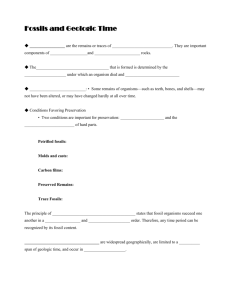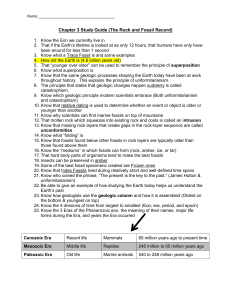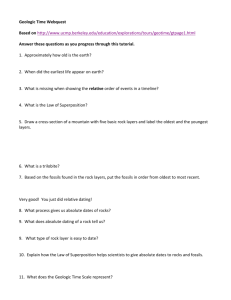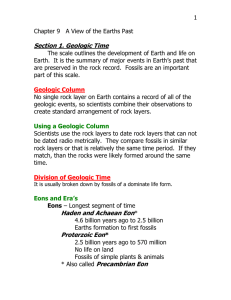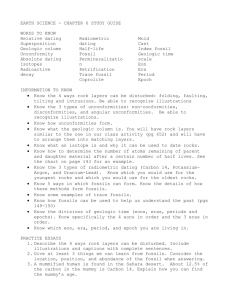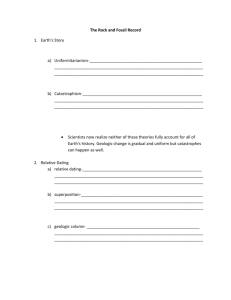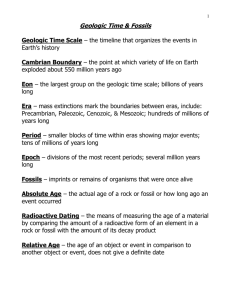My Time Scale: Introduction to Relative and Absolute Dating Activity
advertisement
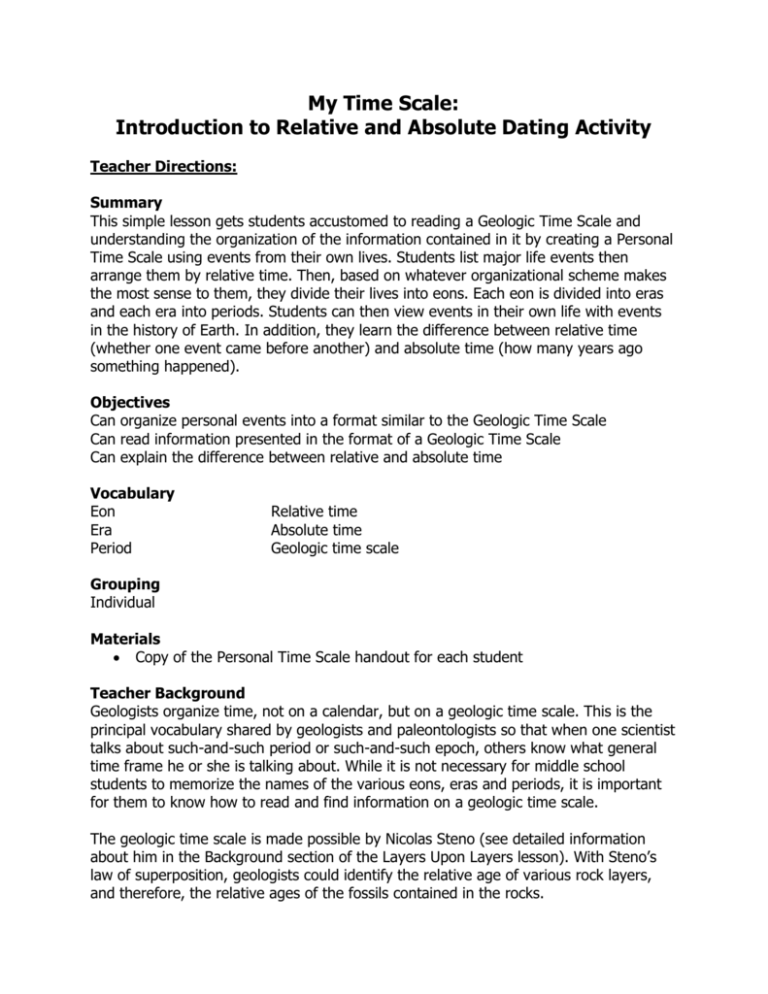
My Time Scale: Introduction to Relative and Absolute Dating Activity Teacher Directions: Summary This simple lesson gets students accustomed to reading a Geologic Time Scale and understanding the organization of the information contained in it by creating a Personal Time Scale using events from their own lives. Students list major life events then arrange them by relative time. Then, based on whatever organizational scheme makes the most sense to them, they divide their lives into eons. Each eon is divided into eras and each era into periods. Students can then view events in their own life with events in the history of Earth. In addition, they learn the difference between relative time (whether one event came before another) and absolute time (how many years ago something happened). Objectives Can organize personal events into a format similar to the Geologic Time Scale Can read information presented in the format of a Geologic Time Scale Can explain the difference between relative and absolute time Vocabulary Eon Era Period Relative time Absolute time Geologic time scale Grouping Individual Materials Copy of the Personal Time Scale handout for each student Teacher Background Geologists organize time, not on a calendar, but on a geologic time scale. This is the principal vocabulary shared by geologists and paleontologists so that when one scientist talks about such-and-such period or such-and-such epoch, others know what general time frame he or she is talking about. While it is not necessary for middle school students to memorize the names of the various eons, eras and periods, it is important for them to know how to read and find information on a geologic time scale. The geologic time scale is made possible by Nicolas Steno (see detailed information about him in the Background section of the Layers Upon Layers lesson). With Steno’s law of superposition, geologists could identify the relative age of various rock layers, and therefore, the relative ages of the fossils contained in the rocks. After Steno, a major advance in geology came from William Smith (1769-1839), a surveyor and amateur geologist. In the process of his work as a surveyor, he carefully observed rock layers all across England. He noticed that the fossils not only differed from one rock layer to the next, but that the same sequence of fossils appeared wherever he looked. His observation came to be known as the principle of faunal succession – since layers of sedimentary rock contain fossils in a specific sequence, and since the relative age of rock layers can be determined by superposition, rock layers may be correlated in time by the fossils they contain. In one series of rock layers, fossils A, B, C, D, and E could be found from bottom to top. Elsewhere in England, fossils D, E, F, G, and H were found in sequence. Thus, rocks containing fossil G and H are younger rocks containing fossil A, even though they aren’t found in the same place. This use of fossils to identify the order of rock layers in the overall stratigraphic column allowed Smith to create a complete geologic map of England. Moreover, the principle of faunal succession allowed geologists worldwide to organize rocks and fossils into their relative temporal order. Based on these observations, major differences in the types of fossilized organisms found led scientists to organize the time scale into broad categories called eons, then subcategories called eras, and so on through finer and finer divisions of time. Only recently, since the 1950’s with the invention of the mass spectrometer and its application towards the radiometric dating of rocks, has it been possible to determine the actual ages of rocks and the fossils they contain. Student Prerequisites None Activity Procedures 1. Begin the day with a discussion of time. How do you think about historical events? Do you categorize events by decade? Do you categorize events by major turning points in history like the American Revolution and the Civil War? How about events in your own life? Do you categorize things by what school you attended? Do you categorize things by where you lived? Do you categorize things relative to major family events like the birth of a sibling or a divorce? 2. Today we will be organizing events like geologists do and become familiar with the format of the time scale used to organize information about Earth history. 3. Pass out the handouts and explain the general directions described on the first page: a. Create a list of at least 10 major events in your lifetime b. Place a number beside each event according to which happened longest ago (1) and which happened most recently (10) c. Rewrite the list in reverse chronological order, with the most recent at the top and the most long ago at the bottom d. To the new list, add information about exactly how many years ago the event occurred 4. The list so far is what geologists refer to as a relative or sequential timeline. Discuss the difference between relative time, ordering events by which happened first, and absolute time, the number of years ago each event happened. A relative timeline can be observed from rock layers just by reading it from bottom to top. But is it possible to observe the actual, absolute number of years ago a rock layer formed just by looking at it? No. You can determine absolute time for events from your own life because you can remember each event, but nobody can remember the exact, absolute age of a rock. Scientists use special tools to find the absolute, number of years ago a given rock layer was formed. More on this in later lessons. 5. After the discussion about relative and absolute time, students can categorize events into a hierarchical series of time periods. Students should think about a logical way to divide their life events into 2 categories such as “before I started school” and “after I started school” or perhaps “when I lived in New York” and “when I lived in Ohio”. These will form the largest divisions of your personal time scale and will be called eons. 6. Students should draw a horizontal line across the eon, era and period columns, dividing their table according to the criteria they chose. They should name the categories with a 1 word label that ends in the suffix –ian or –ic. For instance, “Preschoolian” and “Schoolian” or “Newyorkian” and “Ohioan”. In the eon column, they should write down the names they chose. 7. Now students should divide each of the eons into 2 or 3 eras based on a different criteria. For instance, the “Schoolian Eon” can be divided into the “Elementarian Era” and the “Middleschoolian Era”. Students should divide their tables by drawing a line across the era and period columns according to the criteria they chose and should write in the name of the eras. 8. Finally, students should divide each era into 2 or 3 periods, if that is possible. If an era contains only a single event, then you don’t have to divide it. Students should divide their tables by drawing a line across the period column and should write in the name of the period. 9. If you have remaining time, students can color their tables or share them with one another in small groups. 10. Instruct students that we will be studying Earth’s Time Scale throughout this unit. Sources Activity adapted from http://www.mysciencebox.org/mytime This activity was inspired by the lesson Sequencing Time by Judith Scotchmoor (http://www.ucmp.berkeley.edu/fosrec/ScotchmoorTime.html She has created the definitive web resource for educators trying to teach geology and Earth history (http://www.ucmp.berkeley.edu/exhibit/geology.html). Here you can find detailed information about each eon, era, period and epoch in Earth History. Furthermore, you can learn about how the geologic time scale was created and how it is organized. My Time Scale: Major Life Events *DO NOT WRITE ON THIS PAPER. WRITE ANSWERS IN YOUR NOTEBOOK!* Step 1: In your notebook, list at least 10 of the most important events of your lifetime. Use these events as your first 4 on your list: ___ _Today_____________________________________________ _1 _ _I was born__________________________________________ ___ _I started going to kindergarten_________________________ ___ _I learned to walk_____________________________________ (Continue listing other important events… come up with at least 10!) Step 2: Arrange these events in order by placing a 1 in front of the event that occurred first and a number 2 for the event that occurred second, etc. Step 3: Your teachers has passed out a sheet titled “My Time Scale”. Locate this! Step 4: In the LAST column, write these events in order from most recent to longest time ago. “Today” should be on the top of the list and “I was born” should be on the bottom. Step 5: In the FORTH column, write how many years ago each event happened. Write your entries using decimals. For example, 2 years 6 months ago = 2.5 years ago. (If you aren’t exactly sure how many years ago, make your best guess!) Wait for further instructions. If you have extra time, add more events to your time scale! Fold this flap back using the line below as a guide. Then glue this side (tab) to your NOTEBOOK. My Time Scale EON ERA PERIOD YRS AGO MAJOR EVENTS

